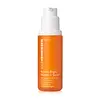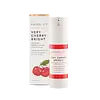What's inside
What's inside
 Key Ingredients
Key Ingredients

 Benefits
Benefits

 Concerns
Concerns

No concerns
 Ingredients Side-by-side
Ingredients Side-by-side

Water
Skin ConditioningSqualane
EmollientDimethicone
EmollientCetearyl Alcohol
EmollientGlycerin
HumectantCaprylic/Capric Triglyceride
MaskingIsododecane
EmollientPolymethylsilsesquioxane
Mica
Cosmetic ColorantCoconut Alkanes
EmollientCI 77891
Cosmetic ColorantSclerocarya Birrea Seed Oil
HumectantDilinoleic Acid/Propanediol Copolymer
Emollient3-O-Ethyl Ascorbic Acid
Skin ConditioningCetearyl Methicone
Skin ConditioningSilica
AbrasivePhenoxyethanol
PreservativeCetearyl Glucoside
EmulsifyingXylitylglucoside
HumectantDimethicone/Vinyltrimethylsiloxysilicate Crosspolymer
Anhydroxylitol
HumectantMicrocrystalline Cellulose
AbsorbentPotassium Cetyl Phosphate
EmulsifyingStevioside
MaskingPolysilicone-11
Coco-Caprylate/Caprate
EmollientHydroxyethyl Acrylate/Sodium Acryloyldimethyl Taurate Copolymer
Emulsion StabilisingAcrylates/C10-30 Alkyl Acrylate Crosspolymer
Emulsion StabilisingXylitol
HumectantTocopherol
AntioxidantParfum
MaskingPotassium Azeloyl Diglycinate
Skin ConditioningCI 77491
Cosmetic ColorantDipotassium Glycyrrhizate
HumectantEthylhexylglycerin
Skin ConditioningGlucose
HumectantXanthan Gum
EmulsifyingSodium Citrate
BufferingCitrus Aurantium Dulcis Fruit Extract
MaskingCitrus Limon Fruit Extract
MaskingHippophae Rhamnoides Extract
MaskingLycium Barbarum Fruit Extract
AstringentRosa Canina Fruit Extract
AstringentSodium Hydroxide
BufferingLeuconostoc/Radish Root Ferment Filtrate
AntimicrobialPolysorbate 60
EmulsifyingSorbitan Isostearate
EmulsifyingAscorbic Acid
AntioxidantAroma
Sodium Chloride
MaskingCitral
PerfumingLimonene
PerfumingLinalool
PerfumingWater, Squalane, Dimethicone, Cetearyl Alcohol, Glycerin, Caprylic/Capric Triglyceride, Isododecane, Polymethylsilsesquioxane, Mica, Coconut Alkanes, CI 77891, Sclerocarya Birrea Seed Oil, Dilinoleic Acid/Propanediol Copolymer, 3-O-Ethyl Ascorbic Acid, Cetearyl Methicone, Silica, Phenoxyethanol, Cetearyl Glucoside, Xylitylglucoside, Dimethicone/Vinyltrimethylsiloxysilicate Crosspolymer, Anhydroxylitol, Microcrystalline Cellulose, Potassium Cetyl Phosphate, Stevioside, Polysilicone-11, Coco-Caprylate/Caprate, Hydroxyethyl Acrylate/Sodium Acryloyldimethyl Taurate Copolymer, Acrylates/C10-30 Alkyl Acrylate Crosspolymer, Xylitol, Tocopherol, Parfum, Potassium Azeloyl Diglycinate, CI 77491, Dipotassium Glycyrrhizate, Ethylhexylglycerin, Glucose, Xanthan Gum, Sodium Citrate, Citrus Aurantium Dulcis Fruit Extract, Citrus Limon Fruit Extract, Hippophae Rhamnoides Extract, Lycium Barbarum Fruit Extract, Rosa Canina Fruit Extract, Sodium Hydroxide, Leuconostoc/Radish Root Ferment Filtrate, Polysorbate 60, Sorbitan Isostearate, Ascorbic Acid, Aroma, Sodium Chloride, Citral, Limonene, Linalool
Water
Skin ConditioningGlycerin
Humectant3-Glyceryl Ascorbate
AntioxidantPrunus Cerasus Fruit Water
Emollient3-O-Ethyl Ascorbic Acid
Skin ConditioningSodium Citrate
BufferingPropanediol
SolventMalpighia Punicifolia Fruit Extract
AntioxidantAscorbyl Tetraisopalmitate
AntioxidantGlucomannan
Skin ConditioningSodium Hyaluronate Crosspolymer
HumectantSodium Hyaluronate
HumectantHydrolyzed Sodium Hyaluronate
Skin ConditioningSodium Acetylated Hyaluronate
HumectantCalendula Officinalis Flower Extract
MaskingAllantoin
Skin ConditioningHydrolyzed Plukenetia Volubilis Seed Extract
Emulsion StabilisingPhysalis Angulata Extract
Skin ProtectingSorbitol
HumectantSodium Phytate
Biosaccharide Gum-1
HumectantPrunus Amygdalus Dulcis Fruit Extract
Skin ConditioningOryza Sativa Bran Extract
Skin ConditioningHelianthus Annuus Extract
EmollientSimmondsia Chinensis Seed Oil
EmollientTocopherol
AntioxidantRosmarinus Officinalis Leaf Extract
AntimicrobialVanilla Planifolia Fruit Extract
Skin ConditioningGlyceryl Caprylate
EmollientEthylhexylglycerin
Skin ConditioningCaprylyl Glyceryl Ether
CleansingSclerotium Gum
Emulsion StabilisingLithospermum Erythrorhizon Root Extract
Skin ConditioningCitric Acid
BufferingPolyglyceryl-4 Caprate
EmulsifyingPentylene Glycol
Skin ConditioningPolyglyceryl-6 Caprylate
EmulsifyingButylene Glycol
HumectantCaprylic/Capric Triglyceride
MaskingCaprylhydroxamic Acid
Sodium Levulinate
Skin ConditioningSodium Anisate
AntimicrobialSodium Benzoate
MaskingWater, Glycerin, 3-Glyceryl Ascorbate, Prunus Cerasus Fruit Water, 3-O-Ethyl Ascorbic Acid, Sodium Citrate, Propanediol, Malpighia Punicifolia Fruit Extract, Ascorbyl Tetraisopalmitate, Glucomannan, Sodium Hyaluronate Crosspolymer, Sodium Hyaluronate, Hydrolyzed Sodium Hyaluronate, Sodium Acetylated Hyaluronate, Calendula Officinalis Flower Extract, Allantoin, Hydrolyzed Plukenetia Volubilis Seed Extract, Physalis Angulata Extract, Sorbitol, Sodium Phytate, Biosaccharide Gum-1, Prunus Amygdalus Dulcis Fruit Extract, Oryza Sativa Bran Extract, Helianthus Annuus Extract, Simmondsia Chinensis Seed Oil, Tocopherol, Rosmarinus Officinalis Leaf Extract, Vanilla Planifolia Fruit Extract, Glyceryl Caprylate, Ethylhexylglycerin, Caprylyl Glyceryl Ether, Sclerotium Gum, Lithospermum Erythrorhizon Root Extract, Citric Acid, Polyglyceryl-4 Caprate, Pentylene Glycol, Polyglyceryl-6 Caprylate, Butylene Glycol, Caprylic/Capric Triglyceride, Caprylhydroxamic Acid, Sodium Levulinate, Sodium Anisate, Sodium Benzoate
 Reviews
Reviews

Ingredients Explained
These ingredients are found in both products.
Ingredients higher up in an ingredient list are typically present in a larger amount.
You might know this ingredient as Ethyl Ascorbic Acid, a more stable version of ascorbic acid.
Like other types of vitamin C, this ingredient has many benefits including reducing wrinkles, skin soothing, dark spot fading, and fighting against free radicals.
3-O-Ethyl Ascorbic Acid interferes with the process of skin darkening, helping to reduce hyperpigmentation. It also encourages the skin to produce more collagen.
Once applied, 3-O-Ethyl Ascorbic Acid is converted to Vitamin C deeper in the skin's layers. This process is slow but makes this ingredient more tolerable for skin.
The optimum pH range for this ingredient is 4 - 5.5
Learn more about 3-O-Ethyl Ascorbic AcidThis ingredient is an emollient, solvent, and texture enhancer. It is considered a skin-softener by helping the skin prevent moisture loss.
It helps thicken a product's formula and makes it easier to spread by dissolving clumping compounds.
Caprylic Triglyceride is made by combining glycerin with coconut oil, forming a clear liquid.
While there is an assumption Caprylic Triglyceride can clog pores due to it being derived from coconut oil, there is no research supporting this.
Learn more about Caprylic/Capric TriglycerideEthylhexylglycerin (we can't pronounce this either) is commonly used as a preservative and skin softener. It is derived from glyceryl.
You might see Ethylhexylglycerin often paired with other preservatives such as phenoxyethanol. Ethylhexylglycerin has been found to increase the effectiveness of these other preservatives.
Glycerin is already naturally found in your skin. It helps moisturize and protect your skin.
A study from 2016 found glycerin to be more effective as a humectant than AHAs and hyaluronic acid.
As a humectant, it helps the skin stay hydrated by pulling moisture to your skin. The low molecular weight of glycerin allows it to pull moisture into the deeper layers of your skin.
Hydrated skin improves your skin barrier; Your skin barrier helps protect against irritants and bacteria.
Glycerin has also been found to have antimicrobial and antiviral properties. Due to these properties, glycerin is often used in wound and burn treatments.
In cosmetics, glycerin is usually derived from plants such as soybean or palm. However, it can also be sourced from animals, such as tallow or animal fat.
This ingredient is organic, colorless, odorless, and non-toxic.
Glycerin is the name for this ingredient in American English. British English uses Glycerol/Glycerine.
Learn more about GlycerinSodium Citrate is the sodium salts of citric acid. In skincare, it is used to alter pH levels and acts as a preservative.
Its main functions are to maintain the pH of a product and neutralize metal ions.
The acidity of our skin is maintained by our glands and skin biome; normal pH level of skin is slightly acidic (~4.75-5.5).
Being slightly acidic allows our skin to create an "acid mantle". This acid mantle is a thin barrier that protects our skin from bacteria and contaminants.
Learn more about Sodium CitrateTocopherol (also known as Vitamin E) is a common antioxidant used to help protect the skin from free-radicals and strengthen the skin barrier. It's also fat soluble - this means our skin is great at absorbing it.
Vitamin E also helps keep your natural skin lipids healthy. Your lipid skin barrier naturally consists of lipids, ceramides, and fatty acids. Vitamin E offers extra protection for your skin’s lipid barrier, keeping your skin healthy and nourished.
Another benefit is a bit of UV protection. Vitamin E helps reduce the damage caused by UVB rays. (It should not replace your sunscreen). Combining it with Vitamin C can decrease sunburned cells and hyperpigmentation after UV exposure.
You might have noticed Vitamin E + C often paired together. This is because it is great at stabilizing Vitamin C. Using the two together helps increase the effectiveness of both ingredients.
There are often claims that Vitamin E can reduce/prevent scarring, but these claims haven't been confirmed by scientific research.
Learn more about TocopherolWater. It's the most common cosmetic ingredient of all. You'll usually see it at the top of ingredient lists, meaning that it makes up the largest part of the product.
So why is it so popular? Water most often acts as a solvent - this means that it helps dissolve other ingredients into the formulation.
You'll also recognize water as that liquid we all need to stay alive. If you see this, drink a glass of water. Stay hydrated!
Learn more about Water